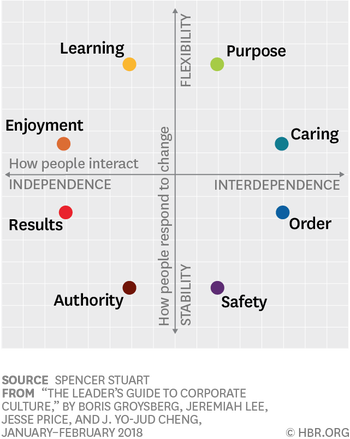In this article the authors say that culture norms define what is encouraged, discouraged, accepted, or rejected within a group. When properly aligned with personal values, drives, and needs; culture can unleash tremendous amounts of energy toward a shared purpose and foster an organization’s capacity to thrive. Whereas strategy is typically determined by the C-suite, culture can fluidly blend the intentions of top leaders with the knowledge and experiences of frontline employees. They contend that the four generally accepted attributes of a culture are:
- shared
- pervasive
- enduring
- implicit
To understand a company’s culture requires determining where it falls along the two dimensions of:
- People interactions (highly independent to highly interdependent)
- Responses to change (emphasize consistency / predicability to emphasize flexibility / adaptability)
Considering these two factors, they have identified or labelled eight different styles that apply to a company's culture (and individual leaders).
Caring focuses on relationships and mutual trust.
Purpose is exemplified by idealism and altruism.
Learning is characterized by exploration, expansiveness, and creativity.
Enjoyment is expressed through fun and excitement.
Results is characterized by achievement and winning.
Authority is defined by strength, decisiveness, and boldness.
Safety is defined by planning, caution, and preparedness.
Order is focused on respect, structure, and shared norms.
Proximate styles, such as safety and order, or learning and enjoyment, will coexist more easily than styles that are far apart on the chart.
Identifying your organization’s culture in this suggested framework will help you assess its intended and unintended consequences; and help you design an aspirational culture and the steps necessary to achieve it.
If you want to effect change, the authors suggest there are four levers for evolving a culture:
-Articulate the aspiration
-Select and develop leaders who align with that target culture
-Use organizational conversation about culture to underscore the important of change
-Reinforce the desired change through organizational design

 RSS Feed
RSS Feed